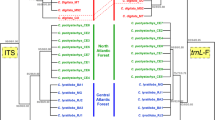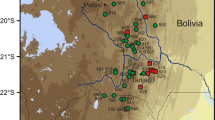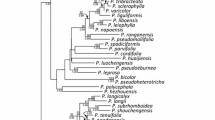Abstract
Tragopogon is an Old World genus with 150 species. Mediterranean, Middle East, and Eastern Europe are the distribution centers of this genus. This genus has 26 species in Iran, of which 11 are endemic. The morphology studies of 32 species and Molecular studies (ISSR, ITS, cp DNA) of 22 species of the genus Tragopogon were investigated. Despite the anatomical and molecular studies done around the world, the exact classification of this genus is not clear due to the high number of secret species, hybridization, polyploidy, and rapid diversification. The purpose of these studies is to classify, determine interspecific relationship in this genus, and determine the important morphological characteristics in taxon differentiation. We conclude that sections of Rubriflori, Sosnowskya, Chromopappus, Majores, Angustissimi, and Krascheninnikovia introduced by the flora of Iranica are confirmed by our morphometry and molecular studies. Section of Profundisulcati in flora Iranica is confirmed based on morphometry data. The Species of T. jesdianus, T. porphyrocephalus, T. rezaiyensis, and T. Stroterocarpus in the flora of Iranica are not classified in any section which we classified in the Rubriflori section. Cp DNA dendrogram is not useful for classification in this genus and Chloroplast sequences are very similar among Tragopogon species. Therefore, the use of cp DNA markers in the classification of this genus is not recommended. The use of ISSR and ITS molecular markers are useful for classifying the genus Tragopogon.






Similar content being viewed by others
References
Azizi H, Sheidai M, Mozaffarian V, Noormohammadi Z (2021) Pollen morphology of the genus Tragopogon (Asteraceae). Acta Bot Hung 63(1–2):31–43. https://doi.org/10.1556/034.63.2021.1-2.2
Bell CD, Mavrodiev EV, Soltis PS, Calaminus AK, Albach DC, Cellinese N, Garcia-Jacas N, Soltis DE (2012) Rapid diversification of Tragopogon and ecological associates in Eurasia. J Evol Biol 25:2470–2480. https://doi.org/10.1111/j.1420-9101.2012.02616.x
Blanca G, Diazdela Guardia C (1997) Fruit morphology in Tragopogon L. (Compositae: Lactuceae) from the Iberian Peninsula. Bot J Linn 125:319–329
Borisova AG (1964). Tragopogon L. In: Bobrov EG, Tzvelev NN (eds) Flora of USSR Compositae Tribe Cichorieae, vol.29. Smithsonian Institution Libraries, Washington D.C., pp 115–196
Bremer K (1994) Asteraceae: cladistics and classification. Timber Press, Portland
Buggs RJA, Soltis PS, Mavrodiev EV, Symonds VV, Soltis DE (2008) Does phylogenetic distance between parental genomes govern the success of polyploids. Castanea 73(2):74–93. https://doi.org/10.2179/0008-7475
Coskuncelebil K, Gultepe M, Guzel ME, Makbul S (2020) Tragopogon abbreviatus (Asteraceae): a little-known species inferred from morphological and molecular analysis. Turk J Bot 44:269–280. https://doi.org/10.3906/bot-1911-38
Falush D, Stephens M, Pritchard JK (2007) Inference of population structure using multilocus genotype data: dominant markers and null alleles. Mol Ecol Notes 7:574–578
Hamer Q, Harper DA, Rayan PD (2012) PAST: paleontological statistics software package for education and data analysis. Palaeontol Electron 4:9
Hatami E, Mirtadzadini M, Bordbar F, Jones KE (2020) Delimitation of Iranian species of scrozonera subg. podospermum and S. subg. Pseudopodospermum (Asteraceae, Cichorieae) based on morphological and molecular data. Willdenomia 50:39–63
Kashin AS, Berezutsky MA, Kochanova IS, Dobrynicheva NV, Polyanskaya MV (2007) Pecularities of seed reproduction in populations of Asteraceae species under impact of anthropogenic factors. Botanicheskiy Zhurnal 92(9):1408–1427 ((In Russian))
Mavrodiev EV, Edwards CE, Albach DC, Gitzendanner A, Soltis PS, Soltis DE (2004) Phylogenetic relationships in subtribe Scorzonerinae (Asteraceae: Cichorioideae: Cichorieae) based on ITS sequence data. Taxon 3:699–712
Mavrodiev EV, Tancig M, Sherwood AM, Gitzendanner MA, Rocca J, Soltis PS, Soltis DE (2005) Phylogeny of Tragopogon L. (Asteraceae) based on internal and external transcribed spacer sequencedata. Int J Plant Sci 166:117–133
Mavrodiev EV, Soltis PS, Soltis DE (2008a) Putative parentage of six Old World polyploids in Tragopogon L. (Asteraceae: Scorzonerinae) based on ITS, ETS and plastid sequence data. Taxon 57:1215–1232
Mavrodiev EV, Nawchoo I, Soltis PS, Soltis DE (2008b) Molecular data reveal that the tetraploid Tragopogon kashmirianus (Asteraceae: Lactuceae) is distinct from the North American T. mirus. Bot J Linn 158:391–398
Mavrodiev EV, Albach DC, Speranza P (2008c) A new polyploid species of the genus Tragopogon (Asteraceae, Cichorieae) from Russia. Novon 18:229–232
Mavrodiev EV, Gitzendanner M, Calaminus AK, Baldini RM, Soltis PS, Soltis DE (2012) Molecular phylogeny of Tragopogon L. (Asteraceae) using seven nuclear regions (Adh, GapC, LFY,PI, ITS, ETS and AP3). Webbia 67(2):111–137
Ownbey M (1950) Natural hybridization and amphiploidy in the genus Tragopogon. Am J Bot 37(7):487–499. https://doi.org/10.2307/2438023
Ownbey M, McCollum GD (1953) Cytoplasmic inheritance and reciprocal amphiploidy in Tragopogon. Am J Bot 40:788–796. https://doi.org/10.2307/2438276
Peakall R, Smouse PE (2006) GENALEX 6: genetic analysis in Excel. Population genetic software for teaching and research. Mol Ecol Notes 6:288–295
Pires JC, Lim KY, Kovarik A, Matyasek R, Boyd A, Leitch AR, Leitch IJ, Bennett MD, Soltis PS, Soltis DE (2004) Molecular cytogenetic analysis recently evolved Tragopogon (Asteraceae) allopolyploids reveal a karyotype that is additive of the diploid progenitors. Am J Bot 91:1022–1035. https://doi.org/10.3732/ajb.91.7.1022
Podani J (2000) Introduction to the exploration of multivariate data. Backhuys Publ, Leiden
Pritchard JK, Stephens M, Donnelly S (2000) Inference of population structure using multilocus genotype data. Genetics 155:945–959
Rechinger KH (1977) Tragopogon. In: Rechinger KH (ed) Flora Iranica, Compositae II, Lactuceae. Osterreich: Akademische Druck- u. Verlagsanstalt
Richardson IBK (1976) Tragopogon. In: Tutin TG, Heywood VH, Burges NA, Moore DM, Valentine DH, Walters SA, Webb DA (eds) Flora Europaea, vol 4. Cambridge Univ. Press, Cambridge
Safavi SR, Naseh Y, Jafari E, Tavakoli Z, Heidar N (1992) Flora Iran, (Asteraceae Tribe cichorieae). Research Institute of Forests and Rangelands, Tehran
Schishkin BK, Bobrov EG (1961) Compositae Tragopogon in Komarov Flora URSS. Doon Scientific Translation co. 318, Chukhuwala, Dehra Dun, India, vol 29, pp 131–196
Shaw J, Lickey EB, Beck JB, Farmer SB, Lium W, Miller J, Siripun KC (2005) The tortoise and the hare II: relative utility of 21 noncoding chloroplast DNA sequences for phylogenetic analysis. Am J Bot 92:142–166
Sheidai M, Zanganeh S, Haji- Ramezani R, Nouroozi M, Noormohammadi Z, Ghasemzadeh- Baraki S (2013) Genetic diversity and population structure in four Cirsium (Asteraceae) species. Biologia 68:384–397
Sheidai M, Afshar M, Keshavarzi M, Talebi SM, Noormohammadi Z, Shafaf T (2014) Genetic diversity and genome size variability in Linum austriacum (Lineaceae) populations. Biochem Syst Ecol 57:20–26
Soltis DE, Soltis PS, Pires JC, Kovarik A, Tate JA et al (2004) Recent and recurrent polyploidy in Tragopogon (Asteraceae): cytogenetic, genomic and genetic comparision. Bot J Linn 82(4):485–501. https://doi.org/10.1111/j.1095-8312.2004.00335.x
Sukhorukov AP, Nilova MV (2015) Carpology of the genus Tragopogon L. (Asteraceae). Phytotaxa 201(1):27–49. https://doi.org/10.11646/phytotaxa.201.1.2
Tamura K, Peterson D, Peterson N, Stecher G, Nei M, Kumar S (2011) MEGA5: molecular evolutionary genetics analysis using maximum likelihood, evolutionary distance, and maximum parsimony methods. Mol Biol Evol 28:2731–2739
Timme R, Kuehl EJ, Boore JL, Jansen RK (2007) A comparative analysis of the Lactuca and Helianthus (Asteraceae) plastid genomes: identification of divergent regions and categorization of shared repeats. Am J Bot 94:302–313
White TJ, Bruns S, Lee S, Taylor J (1990) Amplification and direct sequencing of fungal ribosomal RNA genes for phylogenetics. In: Innis MA, Gelfand DH, Sninsky JJ, White TJ (eds) PCR protocols. Academic Press, London, pp 315–322
Funding
The authors have not disclosed any funding.
Author information
Authors and Affiliations
Corresponding author
Ethics declarations
Conflict of interest
The authors declare that they have no conflict of interest.
Additional information
Publisher's Note
Springer Nature remains neutral with regard to jurisdictional claims in published maps and institutional affiliations.
Rights and permissions
Springer Nature or its licensor holds exclusive rights to this article under a publishing agreement with the author(s) or other rightsholder(s); author self-archiving of the accepted manuscript version of this article is solely governed by the terms of such publishing agreement and applicable law.
About this article
Cite this article
Azizi, H., Sheidai, M., Mozaffarian, V. et al. Molecular (ISSR, cp DNA, ITS) and morphological study of the genus Tragopogon L. (Asteraceae). Genet Resour Crop Evol 70, 505–524 (2023). https://doi.org/10.1007/s10722-022-01443-1
Received:
Accepted:
Published:
Issue Date:
DOI: https://doi.org/10.1007/s10722-022-01443-1




